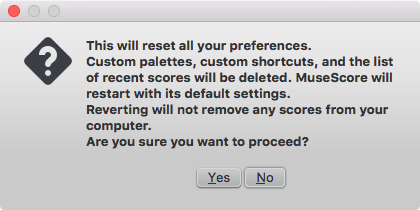Revert to factory settings
MuseScore has the option to revert back to the standard built-in presets or "factory-settings". This can be necessary if your settings are corrupted. Warning: Reverting to factory settings removes any changes you have made to the preferences, palettes, or window settings. This is not a commonly needed procedure; consult the forums first, as there may be a way to solve your problem without resetting everything.
Via menu
If MuseScore still starts, it is possible to revert from within MuseScore.
Go to Help→Revert to Factory Settings. A warning dialog will appear:

Clicking Yes resets all MuseScore's settings as if the program was installed for the first time, and MuseScore will immediately restart. No will safely cancel the revert.
Via command line
If MuseScore does not start, you must run this process via the command line.
Instructions for Windows
- If you have MuseScore open, you need to close it first (File→Quit)
- Type ⊞ Win+R to open the Run dialog. Alternatively select "Start" using your mouse and type "run," then click the "Run" program.
- Click Browse...
- Look for MuseScore3.exe on your computer. The location may vary depending on your installation, but it is probably something similar to My Computer → Local Disk → Program Files → MuseScore 3 → bin → MuseScore3.exe
-
Click Open to leave the Browse dialog and return to the Run dialog. The following text (or something similar) should display in the Run dialog
C:\Program Files\MuseScore 3\bin\MuseScore3.exe(actually%ProgramFiles%\MuseScore 3\bin\MuseScore3.exe)For the 32-bit version of MuseScore in a 64-bit version of Windows, the location is
C:\Program Files (x86)\MuseScore 3\bin\MuseScore3.exe(actually%ProgramFiles(x86)%\MuseScore 3\bin\MuseScore3.exe)For the Windows Store version (Windows 10), it is pretty well hidden, search for it via Windows Explorer
-
Click after the quote and add a space followed by a hyphen and a capital F: -F
- Press OK
After a few seconds, MuseScore should start and all the settings reverted to "factory settings".
For advanced users, the main preference file is located at:
C:\Users\[USERNAME]\AppData\Roaming\MuseScore\MuseScore3.ini
(actually%APPDATA%\MuseScore\MuseScore3.ini)
The other preferences (palettes, session, shortcuts, workspaces...) are in:
-
C:\Users\[USERNAME]\AppData\Local\MuseScore\MuseScore3\(actually%LOCALAPPDATA%\MuseScore\MuseScore3\)For the Windows Store version (Windows 10), these are pretty well hidden, search for them via Windows Explorer
Instructions for MacOS
- If you have MuseScore open, you need to quit the application first (MuseScore→Quit)
- Open Terminal (in Applications/Utilities, or via Spotlight search) and a session window should appear
-
Type (or copy/paste) the following command into your terminal line (include the '/' at the front):
/Applications/MuseScore\ 3.app/Contents/MacOS/mscore -F
This resets all MuseScore preferences to factory settings and immediately launches the MuseScore application. Note that you cannot quit the Terminal without quitting MuseScore. You can safely quit MuseScore, quit the Terminal, and then reopen MuseScore in the normal fashion, ready to continue using.
For advanced users, the main MuseScore preference file is located at ~/Library/Preferences/org.musescore.MuseScore3.plist. Often, deleting this file has no effect: macOS stores a cached copy of the settings in some unknown location. The correct way to delete this file, is by running the following command in the Terminal app:
defaults delete org.musescore.MuseScore3
The other preferences (palettes, session, shortcuts, workspaces...) are in ~/Library/Application\ Support/MuseScore/MuseScore3/. (Those are not cached by macOS.)
Instructions for Linux
The following is true for Ubuntu, and most likely all other Linux distributions and UNIX-style operating systems.
- If you have MuseScore open, you need to quit the application first (File→Quit)
- From the Ubuntu main menu, choose Applications→Accessories→Terminal. A Terminal session window should appear
-
Type, (or copy/paste) the following command into your terminal line (Ctrl+Shift+V to paste in Terminal):
mscore -FOr, if you are using the AppImage version, you must first use the
cdcommand to change directory to wherever you saved the AppImage. For example, if you saved it to your Desktop (and there is only one):cd ~/Desktop ./MuseScore*.AppImage -F
This resets all MuseScore preferences to factory settings and immediately launches the MuseScore application. You can now quit Terminal, and continue using MuseScore.
For advanced users, the main MuseScore preference file is located at ${XDG_CONFIG_HOME:-~/.config}/MuseScore/MuseScore3.ini.
The other preferences (palettes, session, shortcuts, workspaces, …) are in ${XDG_DATA_HOME:-~/.local/share}/MuseScore/MuseScore3/.